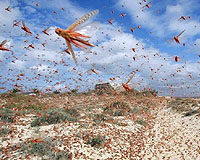 |
Corvallis OR (SPX) Jun 16, 2009 At times in the distant past, an abrupt change in climate has been associated with a shift of seasonal monsoons to the south, a new study concludes, causing more rain to fall over the oceans than in the Earth's tropical regions, and leading to a dramatic drop in global vegetation growth. If similar changes were to happen to the Earth's climate today as a result of global warming - as scientists believe is possible - this might lead to drier tropics, more wildfires and declines in agricultural production in some of the world's most heavily populated regions. The findings were based on oxygen isotopes in air from ice cores, and supported by previously published data from ancient stalagmites found in caves. They will be published in the journal Science by researchers from Oregon State University, the Scripps Institution of Oceanography and the Desert Research Institute in Nevada. The research was supported by the National Science Foundation. The data confirming these effects were unusually compelling, researchers said. "Changes of this type have been theorized in climate models, but we've never before had detailed and precise data showing such a widespread impact of abrupt climate change," said Ed Brook, an OSU professor of geosciences. "We didn't really expect to find such large, fast environmental changes recorded by the whole atmosphere. The data are pretty hard to ignore." The researchers used oxygen measurements, as recorded in air bubbles in ice cores from Antarctica and Greenland, to gauge the changes taking place in vegetation during the past 100,000 years. Increases or decreases in vegetation growth can be determined by measuring the ratio of two different oxygen isotopes in air. They were also able to verify and confirm these measurements with data from studies of ancient stalagmites on the floors of caves in China, which can reveal rainfall levels over hundreds of thousands of years. "Both the ice core data and the stalagmites in the caves gave us the same signal, of very dry conditions over broad areas at the same time," Brook said. "We believe the mechanism causing this was a shift in monsoon patterns, more rain falling over the ocean instead of the land. That resulted in much lower vegetation growth in the regions affected by these monsoons, in what is now India, Southeast Asia and parts of North Africa." Previous research has determined that the climate can shift quite rapidly in some cases, in periods as short as decades or less. This study provides a barometer of how those climate changes can affect the Earth's capacity to grow vegetation. "Oxygen levels and its isotopic composition in the atmosphere are pretty stable, it takes a major terrestrial change to affect it very much," Brook said. "These changes were huge. The drop in vegetation growth must have been dramatic." Observations of past climatic behavior are important, Brook said, but not a perfect predictor of the impact of future climatic shifts. For one thing, at times in the past when some of these changes took place, larger parts of the northern hemisphere were covered by ice. Ocean circulation patterns also can heavily influence climate, and shift in ways that are not completely understood. However, the study still points to monsoon behavior being closely linked to climate change. "These findings highlight the sensitivity of low-latitude rainfall patterns to abrupt climate change in the high-latitude north," the researchers wrote in their report, "with possible relevance for future rainfall and agriculture in heavily-populated monsoon regions." Share This Article With Planet Earth
Related Links Oregon State University Farming Today - Suppliers and Technology
 Local fare gets top billing in 'locavore' food trend
Local fare gets top billing in 'locavore' food trendVancouver, Canada (AFP) June 15, 2009 The succulent braised rabbit served up at Raincity Grill comes garnished with a mound of curled wild lettuce, harvested from the mountains surrounding Vancouver. In fact, the rabbit itself -- and nearly every other menu item at this trendy beachside restaurant -- is from a nearby farm or producers' market. This west coast Canadian city is a mecca for so-called "locavores" who eat ... read more |
|
| The content herein, unless otherwise known to be public domain, are Copyright 1995-2009 - SpaceDaily. AFP and UPI Wire Stories are copyright Agence France-Presse and United Press International. ESA Portal Reports are copyright European Space Agency. All NASA sourced material is public domain. Additional copyrights may apply in whole or part to other bona fide parties. Advertising does not imply endorsement,agreement or approval of any opinions, statements or information provided by SpaceDaily on any Web page published or hosted by SpaceDaily. Privacy Statement |